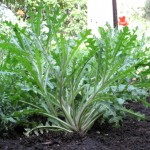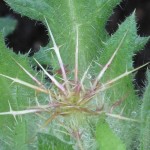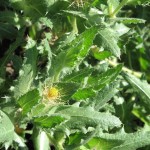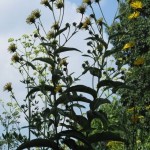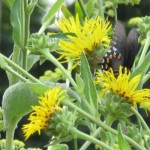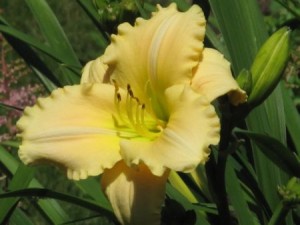Friday, July 30, 2010
Above: Three images of the blessed thistle (Cnicus benedictus). The low stature and unremarkable appearance of this plant belie its medieval reputation as a plague cure and a panacea. The lax stems and spiny, light green leaves are covered with a fine, white down; the spines that subtend the developing flowerhead are a protection against grazing animals. The yellow flowers of this annual thistle appear in July; once the seeds have set, the plant dies. Photographs by Corey Eilhardt.
The humble Cnicus benedictus, a plant of waste ground and stony soil native to the Mediterranean, was a medieval panacea whose reputation survived undiminished into the Renaissance. The sixteenth-century English herbalist John Gerard notes that this wild medicinal plant of southern Europe was “diligently cherished in gardens in these Northern parts.” Gerard also attests that the herb was known everywhere in Europe by the medieval Latin name Carduus benedictus; the common names by which it is known today preserve this designation: blessed or holy thistle in English, benedikten distel in German; chardon b??nit or chardon santo in French, cardo benedetto in Italian, cardo bendito in Spanish.
Read more »
Tags: bitter, blessed thistle, Carduus benedictus, carline thistle, cataplasm, cnecos, Cnicus benedictus, Dioscorides, earbes Carduus Benedictus and Angelica, invasive, John Gerard, Maude Grieve, panacea, pestilence, plague, Pliny, Rufinus, Silybum marianum, thistle, Thomas Brasbridge, weed
Posted in Gardening at The Cloisters, Medicinal Plants | Comments (1)
Tuesday, July 13, 2010
Above, left: Elecampane growing in a bed in Bonnefont garden devoted to??medieval vegetables. The bright yellow flowers of this striking plant are borne high on tall stems that can reach an imposing height of six feet. Right: Detail of the fringed flowers, typical of the daisy family. Photographs by Corey Eilhardt.
The tall and showy elecampane (Inula helenium) is a striking presence along roadsides, in pastures, and on waste grounds both in Europe and in the United States, where it is considered an invasive weed by the U.S.D.A., especially in the moist and shady situations it prefers. It is nevertheless still widely planted in ornamental gardens for its imposing height, bold foliage, and bright yellow flowers, which come into bloom at midsummer. Read more »
Tags: aromatic, daisy, elecampane, inula helenium, inulin, invasive, John Gerard, ornamental
Posted in Food and Beverage Plants, Fragrant Plants, Magical Plants, Medicinal Plants | Comments (1)
Monday, July 5, 2010
Above, left: Jane Hayward in Cuxa garden on July 5, 1993. Jane happily wears a crown of daylilies for the ceremonial planting of a??newly introduced cultivar??named for her that year. Right: Detail of Hemerocallis ‘Jane Hayward’ now blooming in Cuxa garden.
In 1993, Jane Hayward, a curator for the department of Medieval Art and The Cloisters, and an authority on stained glass, had recently celebrated her twenty-fifth anniversary working at the Museum. As passionately devoted to medieval art and to The Cloisters as she was, Jane also had a passion for daylilies,??declaring that??her idea of immortality would be to have a daylily named after her. Read more »
Tags: daylily, Jane Hayward
Posted in Gardening at The Cloisters | Comments (12)
